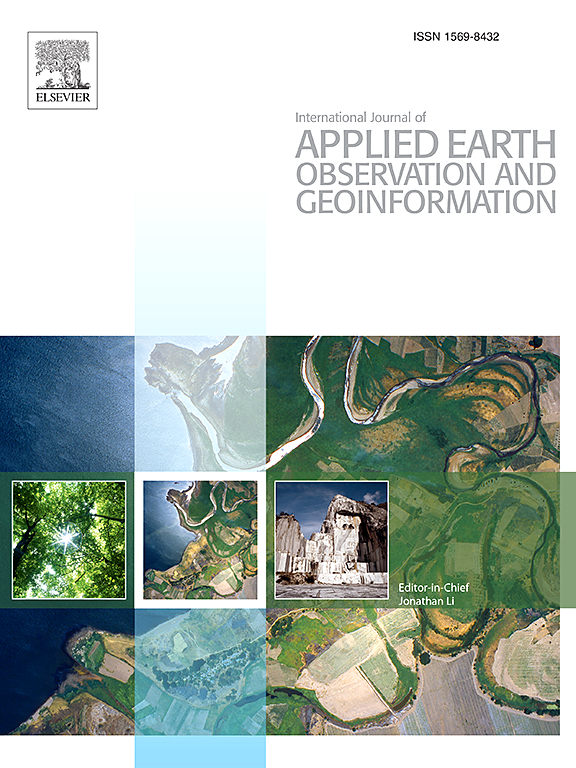Shoreline time series analysis through the Isoradiometric method: Bridging landscape evolution and coastal management
IF 8.6
Q1 REMOTE SENSING
International journal of applied earth observation and geoinformation : ITC journal
Pub Date : 2025-06-02
DOI:10.1016/j.jag.2025.104618
引用次数: 0
Abstract
The increasing availability of remotely sensed data has enhanced our ability to monitor coastal evolution, yet extracting reliable time series for long-term analysis remains a challenge. This study evaluates the effectiveness of the Isoradiometric shoreline extraction Method in producing consistent time series data across different spatial and temporal scales. We applied the method to about 150 multispectral satellite images spanning 40 years, covering two sandy beaches along Sicily’s coast in the central Mediterranean Sea. Our validation approach focused on assessing method consistency across datasets with different spatial resolutions and revisit times. By comparing Landsat and PlanetScope data, we demonstrated that while high-resolution products capture greater variability in shoreline position, lower-resolution but longer time-span observations effectively identify underlying evolutionary trends. The analysis revealed that manual digitization captures instantaneous swash positions, while the Isoradiometric Method consistently identifies stable morphological features between the low tide terrace and berm, providing more reliable indicators of actual coastal change. This multi-resolution approach proved effective in distinguishing between method-related outliers and paroxysmal events, with the latter typically detected across multiple datasets at corresponding timeframes. The systematic application of the Isoradiometric Method successfully characterized both natural variability patterns and anthropic impacts, providing quantitative baselines for interpreting Quaternary coastal processes while offering practical insights for shoreline monitoring and coastal management strategies. Moreover, we calculated the shifts’ gradient to quantify the rate of change in shoreline position. These results demonstrate: i) the necessity of creating shoreline time series as a tool for geological interpretation through the principle of actualism and as a framework for rationalizing contemporary shoreline monitoring approaches; ii) the Isoradiometric Method enables accurate Earth Observation image processing for this purpose.
用等辐射法分析海岸线时间序列:桥接景观演变与海岸管理
越来越多的遥感数据增强了我们监测沿海演变的能力,但提取可靠的时间序列进行长期分析仍然是一个挑战。本研究评估了等辐射海岸线提取方法在不同时空尺度上产生一致时间序列数据的有效性。我们将该方法应用于大约150幅跨越40年的多光谱卫星图像,覆盖了地中海中部西西里岛沿岸的两个沙滩。我们的验证方法侧重于评估具有不同空间分辨率和重访时间的数据集的方法一致性。通过比较Landsat和PlanetScope的数据,我们发现,虽然高分辨率产品捕获了海岸线位置的更大变化,但低分辨率但更长的时间跨度观测有效地识别了潜在的进化趋势。分析表明,人工数字化捕获瞬时冲刷位置,而等辐射方法一致地识别出低潮阶地和护堤之间的稳定形态特征,为实际海岸变化提供了更可靠的指标。事实证明,这种多分辨率方法在区分与方法相关的异常值和突发事件方面是有效的,后者通常在相应的时间框架内跨多个数据集检测到。等辐射测量方法的系统应用成功地描述了自然变率模式和人为影响,为解释第四纪海岸过程提供了定量基线,同时为海岸线监测和海岸管理策略提供了实际见解。此外,我们还计算了位移梯度,以量化海岸线位置的变化率。这些结果表明:i)创建海岸线时间序列是必要的,通过现实主义原则作为地质解释的工具,并作为合理化当代海岸线监测方法的框架;ii)等辐射方法可为此目的对地观测图像进行精确处理。
本文章由计算机程序翻译,如有差异,请以英文原文为准。
求助全文
约1分钟内获得全文
求助全文
来源期刊

International journal of applied earth observation and geoinformation : ITC journal
Global and Planetary Change, Management, Monitoring, Policy and Law, Earth-Surface Processes, Computers in Earth Sciences
CiteScore
12.00
自引率
0.00%
发文量
0
审稿时长
77 days
期刊介绍:
The International Journal of Applied Earth Observation and Geoinformation publishes original papers that utilize earth observation data for natural resource and environmental inventory and management. These data primarily originate from remote sensing platforms, including satellites and aircraft, supplemented by surface and subsurface measurements. Addressing natural resources such as forests, agricultural land, soils, and water, as well as environmental concerns like biodiversity, land degradation, and hazards, the journal explores conceptual and data-driven approaches. It covers geoinformation themes like capturing, databasing, visualization, interpretation, data quality, and spatial uncertainty.
 求助内容:
求助内容: 应助结果提醒方式:
应助结果提醒方式:


